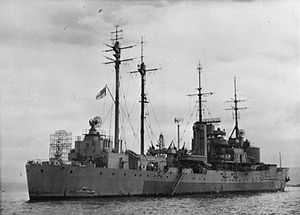HMS Boxer (1942)
 | |
| Career | |
|---|---|
| Name: | HMS Boxer |
| Ordered: | 6 March 1941 |
| Builder: | Harland and Wolff |
| Yard number: | 1155[1] |
| Launched: | 12 December 1942 |
| Completed: | 1 May 1943[1] |
| Commissioned: | 10 April 1943 |
| Fate: | Scrapped 1958 |
| General characteristics | |
| Type: | Landing Ship, Tank Mark I |
| Displacement: | 3,620 |
| Speed: | 18 knots laden to beaching draught 16.5 knots at deep |
| Capacity: | 13 Churchill Infantry tanks, 27 vehicles, 193 men |
| Complement: | 169 |
| Service record | |
|---|---|
| Operations: |
Allied invasion of Italy Normandy Landings |
HMS Boxer, pennant F121, was built as a Landing Ship, Tank (LST) at Harland and Wolff. Launched in December 1942 and commissioned the following April, she saw service as part of the Allied invasion of Italy.
Design and development
HMS Boxer was the next in development of the Landing Ship, Tank following the conversion of the Maracaibo tankers into landing ships capable of carrying vehicles. The requirement was for a ship that could carry 13 Churchill tanks, 27 other vehicles and 193 men. As it was expected to have a high speed even when laden for the assault (about 18 knots) it could not have a shallow draught. This in turn meant that an extra long bow ramp had to be added. At 140 ft (43 m) this took up a lot of room inside the ship.
Boxer had only two sister ships, as plans to build more in the United States led instead to a simpler though slower design capable of similar capacity but with a much shallower draught.
Service
In 1944, she was refitted as a "Fighter Direction Ship", for use during the Normandy landings in controlling fighter aircraft by GCI, then as an "Action Information Organisation" tender[2] (a radar training ship) in 1946. In 1953 she took part in the Fleet Review to celebrate the Coronation of Queen Elizabeth II,[3] was placed in reserve in 1956, and scrapped at Barrow-in-Furness in 1958.
HMS Boxer carried the writer/comedian Spike Milligan from North Africa to Italy when he served with the 56th Heavy Regiment Royal Artillery.[4]
Commanding officers
| From | To | Captain |
|---|---|---|
| 1953 | 1953 | Captain H A F Hunt RN |
| 1955 | 1956 | |
See also
- HMS Bruiser
- HMS Thruster
References
- ↑ 1.0 1.1 McCluskie, Tom (2013). The Rise and Fall of Harland and Wolff. Stroud: The History Press. p. 151. ISBN 9780752488615.
- ↑ Navigating and Direction Officers Association
- ↑ Souvenir Programme, Coronation Review of the Fleet, Spithead, 15th June 1953, HMSO, Gale and Polden
- ↑ Milligan, Spike (1978) Mussolini, His Part In My Downfall, Hobbs, J. (Ed.), Harmondsworth : Penguin, 288 p., ISBN 0-14-005196-1
Publications
- Nelson to Vanguard - Warship design and development 1923-1945 D K Brown
- Colledge, J. J.; Warlow, Ben (2006) [1969]. Ships of the Royal Navy: The Complete Record of all Fighting Ships of the Royal Navy (Rev. ed.). London: Chatham Publishing. ISBN 978-1-86176-281-8. OCLC 67375475.